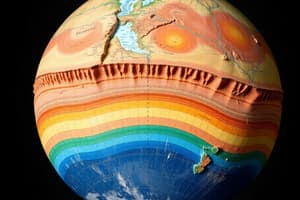Podcast
Questions and Answers
Which scientific theory explains the structure and behavior of the Earth?
Which scientific theory explains the structure and behavior of the Earth?
- Theory of Evolution
- Theory of Plate Tectonics (correct)
- Theory of Creative Destruction
- Theory of Relativity
What did the theory of plate tectonics take many scientists many years to do?
What did the theory of plate tectonics take many scientists many years to do?
- Recycle Earth's material
- Shift our understanding of the Earth
- Create the puzzle pieces
- Tell the story of Earth's broken outer shell (correct)
What is the theory of plate tectonics compared to in other scientific fields?
What is the theory of plate tectonics compared to in other scientific fields?
- Theory of Evolution (correct)
- Theory of Relativity
- Theory of Creative Destruction
- None of the above
How long did it take for the theory of plate tectonics to develop?
How long did it take for the theory of plate tectonics to develop?
What is the theory of plate tectonics often referred to as?
What is the theory of plate tectonics often referred to as?
Flashcards are hidden until you start studying
Study Notes
The Revolution of Plate Tectonics: Understanding Earth's Structure and Behavior
- In the 1960s, a scientific revolution occurred that changed our understanding of Earth's workings.
- The theory of plate tectonics explains the structure and behavior of the Earth, including the formation of continents, oceans, mountains, valleys, volcanoes, and earthquakes.
- Plate tectonics is the result of the collective work of many scientists over a period of time.
- It took years to piece together the scientific puzzle and understand how Earth's broken outer shell interacts with the mantle.
- Plate tectonics involves a continuous process of creative destruction and reconstruction, recycling earth materials between the crust and mantle.
- Similar to Darwin's theory of evolution in biology and Einstein's theory of relativity in physics, plate tectonics has a significant impact on our understanding of Earth science.
- Plate tectonics is considered the grand unifying theory in Earth science.
- The development of plate tectonics spans a timeline of approximately four and a half billion years.
- Plate tectonics explains the movement of Earth's lithospheric plates, which float on the semi-fluid asthenosphere beneath.
- The theory of plate tectonics provides insights into continental drift, the formation of mountain ranges, and the occurrence of volcanic and seismic activity.
- Plate tectonics helps explain geological features such as the Mid-Atlantic Ridge and the Ring of Fire.
- The understanding of plate tectonics has implications for various fields, including geology, geophysics, and seismology.
Studying That Suits You
Use AI to generate personalized quizzes and flashcards to suit your learning preferences.




